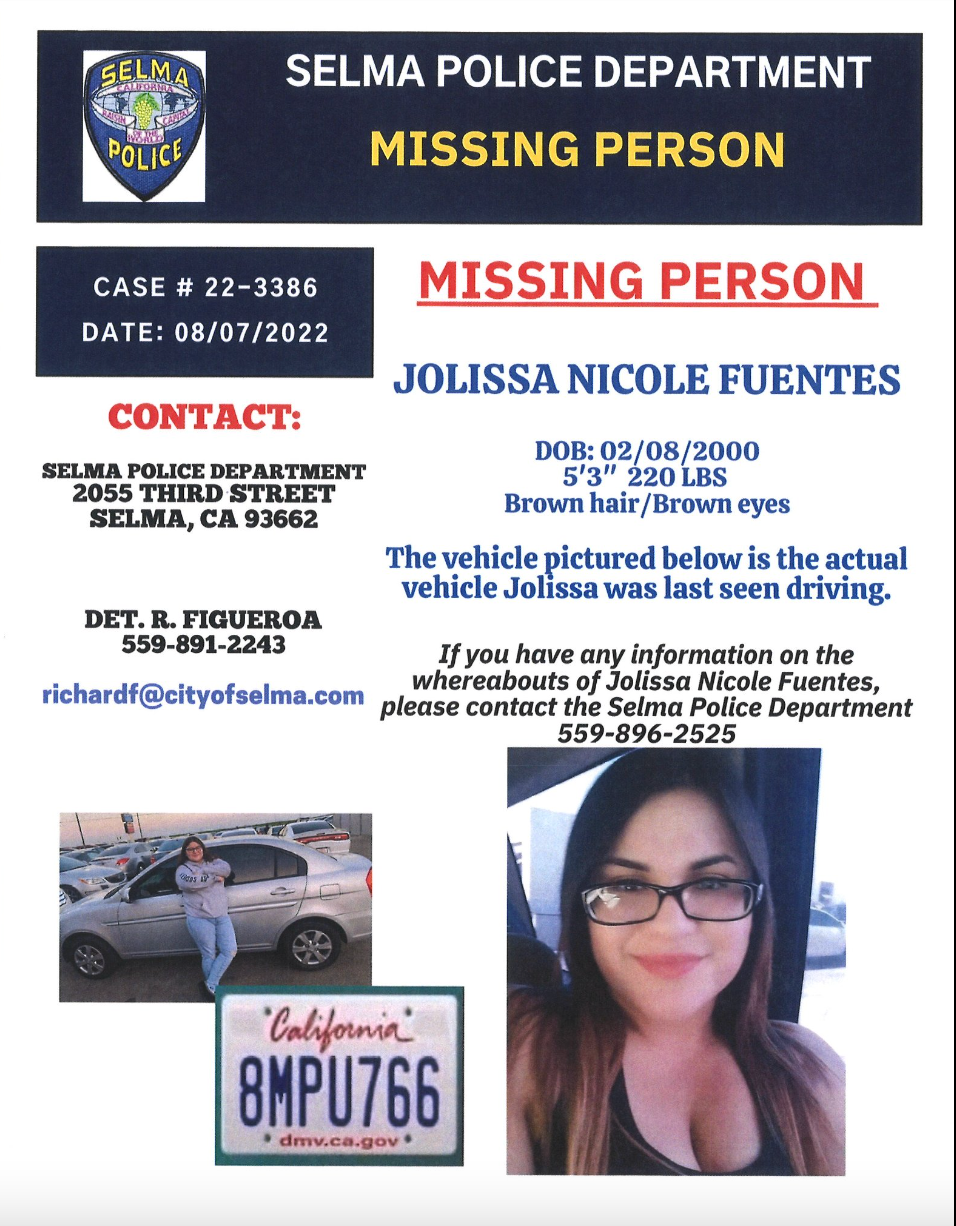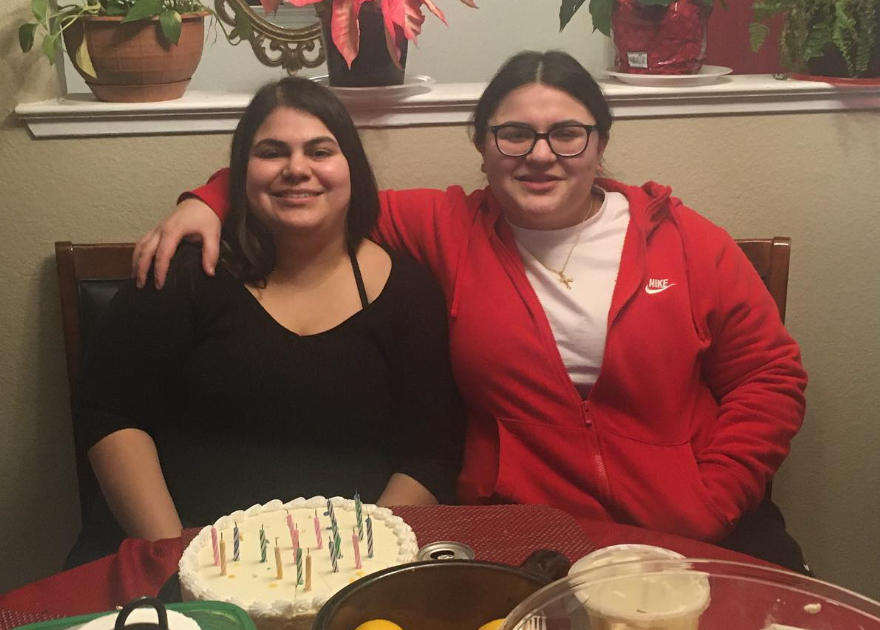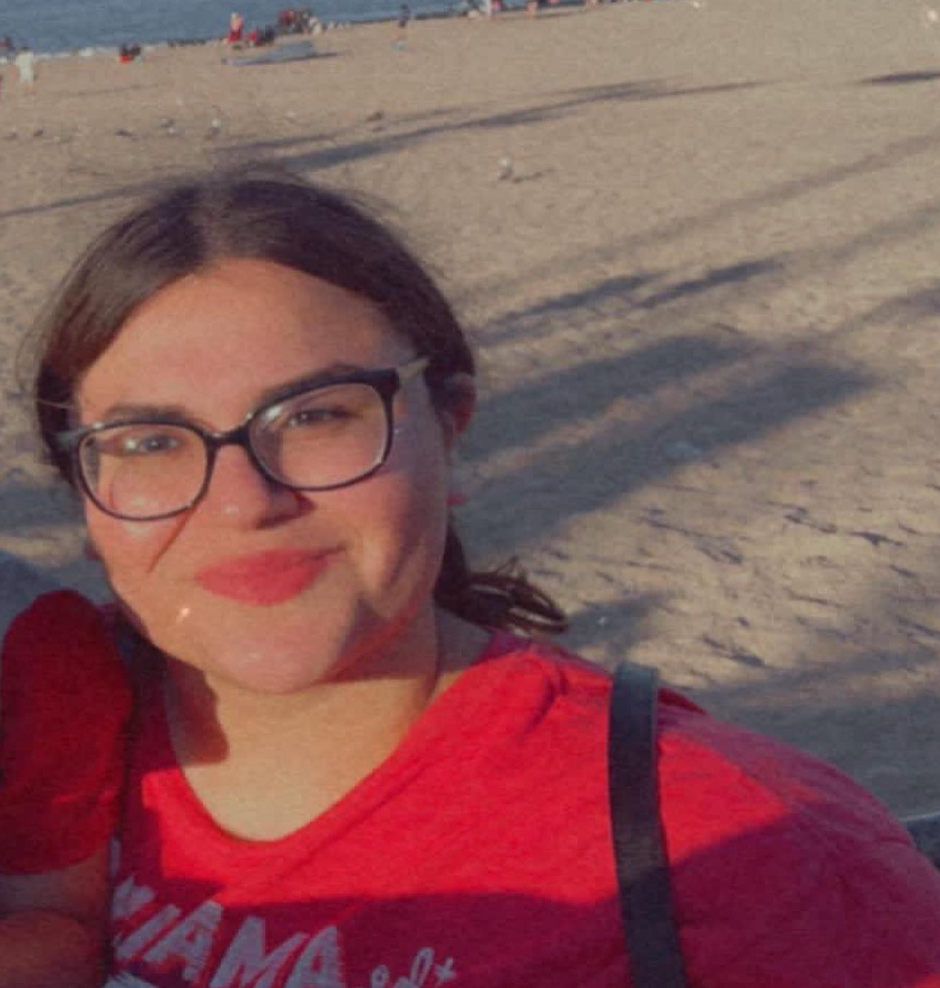
Under intense criticism from the family of a woman who’s been missing for 25 days, the police chief of a small California town pushed an interesting defence: “This isn’t CSI.”
Jolissa Fuentes, 26, was last seen on 7 August leaving a gas station in Selma, a community of less than 25,000 about 16 miles south of Fresno.
Her mother, Norma Nunez tells The Independent it took the local police department nearly two weeks to take the search seriously, leaving the family to rely on loved ones and volunteers to canvass the town’s vast vineyards and orchards for signs of Jolissa.
“The first day we were out there searching. Me, my family, my in-laws, my husband, my niece,” Ms Nunez said. “We searched, searched, searched and not once did we see any cops in the search … for days.”
Selma Police denied the claim and told The Independent that staff from the 40-officer department had searched for Jolissa on foot and used drones the first days after she disappeared.
It wasn’t until 15 days after Jolissa was last seen that authorities announced that the case is being treated as a “criminal matter” - something her family have known from the start, they said. The FBI has since joined the investigation.
As Ms Nunez ramped up her criticism of Selma police in the media, the Fresno County Sheriff’s Office appeared to support her characterisation of the delays by saying the search only gained intensity on 19 August because the sheriff’s office had not been asked by Selma officials to join the efforts sooner.
Probed on why the request took so long, Selma Police Chief Rudy Alcaraz sharply sought to downplay the criticism, telling The Independent that his department only obtained records of where Jolissa’s phone was last pinged about a week after her disappearance and that an analyst from the Fresno Police Department was expeditiously requested.
“We have to see through [the data], so when we do get that data out, we can say we’re looking for help and this is the best-estimated area. It takes time. This is not CSI,” Chief Alcaraz said, referencing the long-running television series Crime Scene Investigation.
Frustrated by police efforts, Jolissa’s family put their faith in an unlikely source: an amateur YouTube dive team that agreed to join the search for Jolissa after helping recover the body of Kiely Rodni, a 16-year-old girl who vanished 306 miles north of Jolissa in Truckee one day earlier.
Ms Nunez said although she is grateful that the team had offered their help, she is relieved they didn’t find anything in the water after days on the case.
“I know she is [out there], we just have to find her,” she told The Independent.

Jolissa’s last known whereabouts
Hours before she vanished, Jolissa had gone to a family gathering on the night of 6 August. She left the party around 3.30am and returned to her home, where she lives with her grandmother and brother, to get some belongings.
Upon leaving the home, she drove to an AM/PM gas station nearby, where surveillance video captured her driving a 2011 Hyundai, with plate 8MPU766, and turning on Nebraska Avenue.
Then, she disappeared.
Jolissa tried to call her sister, Irene Fuentes, at 5.26am but she was sleeping, her mother said. Jolissa’s grandmother then called her at 9am before going to church and “knew something was wrong” when she didn’t pick up the phone, Ms Nunez said.
“Grandma tried to call her and she didn’t get an answer so right there and then we knew that something had happened,” Ms Nunez said.
Irene said that she’s not certain there was something ominous about the call, but added that Jolissa was aware she’s usually always awake around that time.
“She knows I go to bed at 6am. She often tells me ‘I’m going to work now, go to sleep,’” Irene told The Independent. “I don’t know if she was just bored, or was in trouble.”
That same day, Ms Nunez said, Jolissa’s grandmother filed a missing person report.

‘We felt blind-sided’
With the search now in its fourth week, Jolissa’s family have grown more and more frustrated with law enforcement officials they say have “blind-sided” them with the information given to the media.
Jolissa’s phone last pinged in the area near Pine Flat Lake and Avocado Lake, Selma Police told the family the weekend after she disappeared, Ms Nunez said.
She said the immediate family was asked not to publicly share the information so as not to jeopardise the investigation. Irene told The Independent authorities were also concerned that large search parties would disrupt locals in the mountain town and that they would feel unsafe.
But mere days later, as the case gained national attention amid AWP’s discovery of Kiely Rodni’s body, Jolissa’s family learned that Selma Police had shared the information with the media.
“They told us to keep [the location] among ourselves and go search. So, of course, we went to search by ourselves, with our immediate family and then, next thing we know they told Fox News,” Ms Nunez told The Independent.
“We felt blind-sided, we were like, ‘What the hell?’ Okay then, we’re searching the area now. We’re going to have a search party. The whole world knows now,” Ms Nunez said. “I thought ‘I’m going to tell all my family and friends because we need to go search for my baby.’”
Despite the urgency in their report — which was filed just 12 hours after Jolissa was last seen — family members said they did not see police presence during search parties the first days after Jolissa vanished.

Almost a week later after Jolissa went missing, her family went to the police precinct to inquire about possible leads but were told authorities hadn’t received that many.
“On the fifth [day], we went to speak to the sheriff. They basically told us, ‘She’s 22, she’s a grown adult.’ [They said] that she could just up and leave and more time had to pass before they considered foul play,” Irene told The Independent.
“And me and my family were like, ‘How much more time has to pass? A month?’”
Police’s response to criticism
The Selma Police Department was the law enforcement agency that first launched the investigation. The department said they’re conducting a digital investigation into Jolissa’s phone records while the Fresno County Sheriff’s Office has deployed the resources to search for Jolissa on the ground and in the water.
Fresno County Sheriff’s Office told The Independent that the Search and Rescue team had scaled up the search around 19 August, 12 days after Jolissa vanished.
“It seems like [Selma Police] didn’t choose to reach out to us right away,” a spokesperson for the department said. “We do know that the gas station she was last seen at is right outside of the city of Selma, so they could have easily requested our help, but it seems like it took [some] time.”
Speaking to The Independent, Selma PD Chief Alcaraz said that in the aftermath of Jolissa’s disappearance his department chose to reach out to Fresno Police Department because it was the most immediate law enforcement agency.
“We did reach out very quickly to the Fresno Police Department and the specialized unit … and they sent out a specialist to our unit to make sure that we were reading the data the best we could,” he said on Monday.
Chief Alcaraz did not disclose when exactly the cellphone data was received but said it was possibly the weekend after Jolissa went missing. He said it was imperative to thoroughly review data from Jolissa’s phone company before intensifying the search in order to refine the estimated area to be searched.
“It’s a massive area, we cannot just search people wildly. We have to have a refined area,” Chief Alcaraz said on Monday, “If we can, [we try to] refine the search from a 16-sq-mile radio to something more efficient.”
“Just because we have the data, doesn’t mean that it’s ready to go ...“ he added. “Sending people to those areas, we are responsible [to give] them the best information to be successful.”
Fresno County Sheriff’s Office has employed more than 16,000 hours of helicopter search, 20 hours of search on main roadways, and 43 hours of searching bodies of water.
The Search and Rescue Jeep team employed 16 vehicles and searched the pine flat area for a collective total of 280 hours as of Monday last week.
‘We search until there’s no more light’
AWP began their search for Jolissa on the water on 25 August after they successfully recovered the body and vehicle of Kiely Rodni, the 16-year-old teenager who had disappeared on 6 August in Truckee after a bonfire party.
By the time the amateur divers joined the search for Kiely, local authorities had employed more than 25,000 man hours and two weeks of resources.
Within the first hour of searching, the AWP team found the car upside down about 14 feet beneath the Prosser Creek Reservoir’s surface.
The finding brought a semblance of closure for the Rodni family and sparked criticism against law enforcement as they were unable to find Kiely just four miles from Prosser Family Campground, where she was last seen at the party.
On Monday, Ms Nunez told The Independent that AWP had concluded their search for Jolissa after they didn’t find anything in the waters of Pine Flat Lake and Avocado Lake.

It comes as a relief for the family, she said.
Although the prospect that they could have found something was bittersweet, Ms Nunez said she’s grateful the amateur dive team, which has solved 23 missing person cases since 2019, offered their resources.
“We just [wanted] that to get ruled out. If she’s not in the water, let’s move on, please,” Ms Nunez said. “Let’s find her.”
Recounting the immediate aftermath of Jolissa’s disappearance, Ms Nunez said that she felt heartbroken but turned to action and began organising search parties. When the word was out, the community began to show their support.
Some days, up to 80 people show up to search for Jolissa, Irene said.
“People are searching for her on foot. It’s been amazing. A lot of strangers search for her, people with drones, people with dirt biked. They bring my family water, juice,” she told The Independent. “Sometimes they cook us meals, and we are so grateful.”
The family are now raising funds on a GoFundMe page to hire a private investigator.
For 25 days now, the family have continued the same ritual. Jolissa’s parents work an hour here and there before they join her siblings in searching.
When Ms Nunez and her husband go home and try without much success to get some sleep, their children continue putting out flyers. They wake up and prepare for yet another day of searching, of praying, of holding onto the hope that Jolissa will come back home.
“You know, I have to work, so I do a little bit of work and then kick off … We search until the night. Until there’s no more light,” Ms Nunez said.







